Monreale
Tour Guides
Sicily Highlights: Monreale is 147 km. distant from Agrigento, 150 km. from Caltanissetta, 257 km. from Catania, 169 km. from Enna, 267 km. from Messina, 8 km. from Palermo,which province it belongs to, 291 km. from Ragusa, 315 km. from Siracusa, 91 km. from Trapani.
The municipality has 28.715 inhabitants and an area of 52.920 hectares for a density of population of 54 inhabitants per square kilometre. It rises on a hilly area and is 320 metres above sea-level, from it can see a splendid view on the Conca d'Oro (The Gold Basin).
Important is the agricultural field for its remarkable production of citrus fruit, grapes, corn, fruit. In Monreal are moulded pottery articles of exquisite workmanship, mosaics and wicker baskets working also show the importance of the handicraft.
Monreale derives from Latin Mons regalis that means mountain worthy of the king. Originally it was an Arabic country house but it gained a historical importance only in 1174 when William II made built the famous Cathedral and the near Benedectine monastery.
Soon it became one of the largest and rich archbishopric of all the Sicily, and inside there were in the times different kind of religious orders. In 1700 the archbishop Testa made built the street to joint Monreale to the near Palermo.
The Cathedral of Monreale is important for its splendid internal mosaics among them is the figure of the Cristo Pantocratore (Christ Almighty) that stands out for its magnificence in the nave. It represents a valuable mixture of Islamic, Byzantine and Romanesque architecture. Jointed to it there is a beautiful Chiostro (cloister). There is also the Palazzo Vescovile (Archbishop's Palace) and the Church of the Mount.
Welcome to Italy: Suggestively located on a terrace overlooking the Conca d’Oro, this town is worldwide famous for its magnificent Cathedral, situated in its beautiful old town. Construction of this masterpiece of Norman art in Sicily kicked off under William II in 1174 and was finished a few years later; this is why the Cathedral has a stylistic coherence which is seldom found in other ancient buildings. On the outside, you can admire the beautiful doors, the elegant XVI century portico by Gagini and the richly decorated apse, covered in intertwined arches and polychrome lava and limestone inlays. On the inside, you will see its amazing set of mosaics on a golden background. The mosaics, climaxing in the large Christ Pantokrator image, were created between the XII and XIII century and represent stories from the Old and New Testament. It is the largest complete cycle of the Byzantine tradition. William I and II’s porphyry tombs, the XVI century chapel of San Benedetto and the XVII century chapel of the Crucifix, through which you can access the rich Cathedral treasury, are very interesting too. The XI Benedictine cloister is absolutely amazing; inside, you can’t miss the oriental fountain, surrounded by a four-sided colonnade. While in Monreale, we also suggest visiting the remains of the Norman Royal Palace, the Seminar, the Chiesa del Monte, decorated with stuccos by Serpotta, the church of the Collegio di Maria, the XVII church of the Collegiata, the XVII and XVIII century private buildings and the breath-taking Lookout, overlooking the Conca d’Oro.
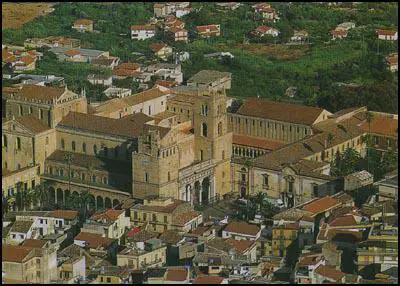
Best of Sicily: Monreale, from "Mons Regalis" (Royal Mountain), is a town of some 25,000 residents located on the slope of Mount Caputo (764 Meters) about 7 kilometers south of Palermo's center. Monreale overlooks the "Conca d'Oro," the beautiful valley beyond Palermo, and the town itself is situated at an altitude of roughly 300 Meters above sea level. No trip to Palermo is truly complete without a visit to Monreale.
Monreale is world-renowned for its cathedral, a dazzling mixture of Arab, Byzantine and Norman artistic styles framed by traditional Romanesque architecture, all combined in a perfect blend of the best that both the Christian and Muslim worlds of the 12th century had to offer. to view some elements of Sicilian church architecture. The beautiful mosaics in Monreale Cathedral are said to be one of the world's largest displays of this art, surpassed only by Istanbul's famous Basilica of Saint Sofia, once an Orthodox church. (Unfortunately, many of those beautiful mosaics were destroyed when the Turks conquered Constantinople in 1453.) Monreale's mosaics emblazon 6,340 square meters of the duomo's interior surface, more than those of the splendid church of Saint Mark in Venice.
The mosaics of "Santa Maria la Nuova," the official name of Monreale Cathedral, are far more extensive than those of the cathedral of Cefalù, and while the mosaics of the Palatine Chapel in Palermo's Norman Palace are of equally exquisite craftsmanship, the latter convey the sense of an elaborate work of art stuffed into a tiny house. In contrast, the mosaics of Monreale's duomo are grandiose, covering practically every inch of the vast interior.
The splendid cloister of the Benedictine abbey alone would make Monreale famous. Located next to the cathedral, these 228 columns, some with mosaic inlay, each with a meticulously stone carved capital, enclose the gardens of the cloister. The capitals themselves depict scenes in Sicily's Norman history, complete with knights and kings. The style of the Norman knight figures evokes that of the knights depicted in the Bayeaux Tapestry, a chronicle of the Battle of Hastings. Historians have determined the date of the introduction of heraldry (coats of arms) in Sicily by the shields of the Monreale knight figures, which lack any heraldic decoration.
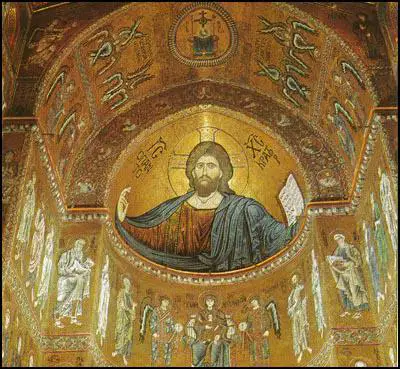
The Sicily Tourist: The Cathedral stand aloof on the edge of the historical centre of Monreale, a small town overlooking the Oreto River valley and the famous “Conca d’Oro”. “The golden Temple”, a fairy-tale construction, the Christian apotheosis of a Norman king’s dream: one morning of 1174, William II, known as “the Good”, Roger II’s grandson and third Norman King of Sicily, awoke early at daybreak and told his ministers he had dreamt of the Virgin Mary asking him to build her a church with the treasure stolen from the State by his father, William I known as “the Bad”, and hidden in a secret place that she would have shown him.
Driven by the desire to emulate his grandfather Roger, the founder of the superb Cefalù Cathedral and Palatine Chapel, the king made his dreams came true by building a church that equalled, and maybe surpassed, the great Roman and Byzantine Christian cathedral in artistic and architectural splendour.
We like to believe (and we are sure we are not mistaken) that he was also driven by his religious faith and by his determination to restore Christian tradition in Sicily, after centuries of neglect due to Muslim rule. In 1174, at the young age of 20, the king began the construction of both the Cathedral and the vast architectural complex including the Benedictine Abbey, the Archbishop Palace and the Royal Palace.
Wikipedia: Monreale (contraction of monte-reale, so-called from a palace built here by Roger I of Sicily) is a small city in the province of Palermo, in Sicily, Italy, on the slope of Monte Caputo, overlooking the beautiful and very fertile valley called "La Conca d'oro" (the Golden Shell), famed for its orange, olive and almond trees, the produce of which is exported in large quantities. The town has approximately 30,000 and is located 15 km (12 mi) south of Palermo.
The town, which for long was a mere village, owed its origin to the founding of a large Benedictine monastery, with its church, the seat of the metropolitan archbishop of Sicily.
The Cathedral of Monreale is the greatest of all the monuments of the wealth and artistic taste of the Norman kings in northern Sicily. It was begun about 1170 by William II, and in 1182 the church, dedicated to the Assumption of the Virgin Mary, was, by a bull of Pope Lucius III, elevated to the rank of a metropolitan cathedral.
The outside of the Arab-Norman cathedral is plain, except the aisle walls and three eastern apses, which are decorated with intersecting pointed arches and other ornaments inlaid in marble.The archiepiscopal palace and monastic buildings on the south side were of great size and magnificence, and were surrounded by a massive precinct wall, crowned at intervals by twelve towers. This has been mostly rebuilt, and but little now remains except ruins of some of the towers, a great part of the monks' dormitory and frater, and the splendid cloister, completed about 1200.
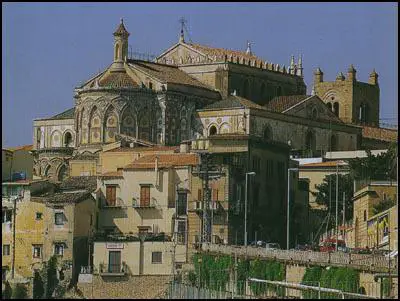
Catholic Encyclopedia: Located in the province of Palermo, Sicily, on the skirts of Mount Caputo. The city is built in a commanding situation over the port of Palermo. It was a pleasure resort of the Norman kings, to whom it owes its foundation. In 1167 William II built there the church of Santa Maria Nuova, with its adjoining monastery for the Benedictines of Cava dei Tirreni - the most superb monastic building of the Benedictine Order in Europe, famous for its cloister and its graceful Moresque colonnade. At the present time only the lower portion of the convent is in the possession of the monks. The church (now the cathedral) is the noblest in Sicily, though the portico of its façade has been restored in a Style not in harmony with the remainder of the building. Its bronze doors, the work of Bonanno of Pisa (1186), are notable, as are also the arabesques of the portals. The interior has three naves, and the columns of Egyptian marble have foiled and figured capitals, each different from the others, The apse and the lateral walls are covered with beautiful mosaics, representing scenes from the Old and New Testaments. The high altar is covered with worked sheets of silver (seventeenth century) and in a chapel to its right, are the tombs of William I the Wicked and of William II. The chapel of Saint Benedict contains sculptures by Marabitti (eighteenth century). In 1811 a fire destroyed the roof, which was restored in a way to leave the rafters exposed to view. On the mountain beyond the city is the monastery of San Martino of the Cassinese Benedictines, whose church is rich in works of art; farther on is the castle of San Benedetto, built by the Saracens. In 1174 the abbey of Monreale was declared a "prælatura nullius"; two years later its abbot was vested with the title and jurisdiction of a bishop, and in 1182 he became the metropolitan of Catania and of Syracuse. At first the archbishops were elected by the monks, but were not always Benedictines; since 1275, however, the election has been reserved to itself by the Holy See. In time Girgenti and Caltagirone also became suffragan to Monreale; but Syracuse, in 1844, and Catania, in 1860, became archiepiscopal sees. The former having become the Metropolitan of Caltagirone, Monreale received the new Diocese of Caltanisetta (1860), which see and Girgenti are now its only suffragans. Among the archbishops of this see have been Cardinal Giovanni Proccamazza (1278); Cardinal Aussio Despuig de Podio (1458); Cardinal Pompeo Colonna (1531); Cardinal Ippolito de' Medici (1532); Alessandro Farnese (1536); Ludovico de Torres (1584), founder of the seminary; Cardinal Vitaliano Visconti (1670); Cardinal Traian d'Acquaviva d'Aragona (1739). From 1775 to 1802 Monreale and Palermo were united. The archdiocese has 30 parishes with 228,600 inhabitants; 352 secular and 66 regular priests; 26 convents of men and one of women; three educational institutes for male students and three for girls.
Holiday Company Descriptions
Riviera Travel: Travelling to the north coast of the island today, we visit the magnificent Benedictine Abbey at Monreale founded by the Norman King William II (also King of England) in the 12th century. During the afternoon we visit Sicily’s capital, Palermo, which under Saracen and Norman rule became one of the most important cities in Europe.
Travel Sicilia: Transfer to Segesta, where we visit the aenigmatic Elimous temple and the Greek theatre, both worldknown symbols of our island. We have lunch at a private estate, surrounded by the Mediterranean vegetation, by the sea and along a pristine beach (if the weather allows it, we can go swimming or sun-bathing). After lunch we go and visit the ruins of Selinunte, the Greek colony founded by Megara Hyblea in the VII century b.C. The archaeological park, with its Doric temples (Sicily is the land of the Doric style) and the town located on top of a cliff, is one of the most important of the Mediterranean. We drive back to Palermo. In the morning we have an exclusive visit to one of the most important private historic houses of Italy, world known as the director Luchino Visconti used its halls to shoot the scene of the ball in his film, The Leopard (from the novel by G. Tomasi di Lampedusa). The rest of the day is free for relax and shopping.
Academic Tours: After breakfast in Palermo, we depart for Segesta to visit the Doric Temple of the 5th century BC. and the Greek Theater. Lunch on your own in Erice and visit of the medieval town. Proceed to Trapani stopping for wine tasting and a visit in Trapani to the Salt Museum with its mines and ancient windmills. Dinner and overnight at your hotel in Marsala.
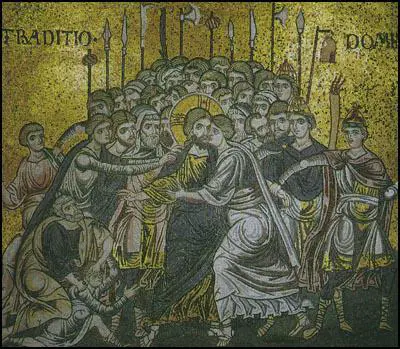
Historic and Cultural Tour of Sicily: Saturday: Arrival at Palermo. Meet your tour escort for a welcome dinner at the hotel. Overnight in Palermo.Sunday: This morning, we'll explore medieval Palermo. We'll visit the Norman abbey of Monreale, overlooking the city, famous for its Byzantine mosaics and Norman-Arab cloister. Then we'll visit some of the city's Norman-Arab sights such as the Palatine Chapel, cathedral and Martorana Church. Afternoon at leisure. Dinner in a local restaurant. Overnight in Palermo.
Splendors of Sicily: A morning tour of this marvelous city of Palermo features the Quattro Canti, a splendid example of Baroque architecture, the Palace of the Normans and its superb Palatine Chapel, the Cathedral, and the famous Benedictine Abbey of Monreale. Here you will admire a 12th century cathedral, housing very fine mosaics representing a complete cycle of the Old and New Testaments, and the Cloisters. Proceed to Monte Pellegrino, a promontory that overlooks Palermo’s bay. Here you may visit Santa Rosalia’s sanctuary, the city’s patron saint. End your morning sightseeing in Mondello, a pretty resort area full of shops and a lovely beach. The afternoon is free. Your Tour Director will recommend an optional outing to the beautiful fishing town of Cefalú. Tonight, bid "addio" to your travel companions during a festive Farewell Dinner in a favorite "locals" restaurant.
Holiday Accommodation
Park Hotel Carrubella: In Monreale artistic-historical centre close to Palermo. The Park Hotel Carrubella is situated on a hill (325 m above sea level) in a charming panoramic position looking on the Conca D’oro; it is only a kilometre far from the “Cathedral of Monreale”, and 5 kilometres far from downtown Palermo and its monuments (the Cathedral of Palermo and Royal Palace). The hotel has 30 rooms with central heating, air conditioning, telephone, private bathroom with shower. Most rooms have a balcony or a panoramic terrace, solarium, free parking.
Hotel Monreale 1215: Excellently located 1000 meters away from the urban center of Monreale and to only 15 minutes from the monumental zone in Palermo, the hotel Monreale 1215, proposes him to his Guests, with the services and the finishing touch of a modern hotel 4 stars. The sobriety and the elegance of the you furnish, the manifold confortses of the rooms, the efficiency and the professionalism of the staff, the all widened by the enchanting sight on the Conca d’Oro and the Gulf in Palermo, makes the hotel Monreale 1215, surely, the ideal destination of any trip.
Casena dei Colli: The Hotel Residence "Casena dei Colli", deep the luxuriant green of the outshirts of the city at the limits of the great park of the Favorita, is situated near important commercial, cultural, sporting and exposistive infrastructures. The rooms, furnished in the traditional Sicilian style, all very spacious, with living/dining-room, cooking point, WC/shower, are furnisched with all comfort: telephone, TV, refrigerator bar and indipendet air conditioning. Al exclusive restaurant and elegant bar, together with conference rooms, garden, garage and private car park, in the suggestive atmosphere of the nearby 18th century villa, make thr Hotel Residence "Casena dei Colli" and ideal reference point for you stay.A shuttle service to the centre of town is at the disposal of our guest.
Hotel Plaza Opéra: The hotel is situated in the shopping and business area of Palermo: a few steps away from viale della Libertà and the Politeama theatre, it is surrounded by art galleries and theatres, by the head offices of the main companies and banks, and also by the best restaurants and wine bars. The most famous monuments and historical and artistic sites making Palermo one of the capital cities of the Mediterranean are within a walking distance. In the lobby, the mixture of antique paintings and engravings and works by modern designers and artists, together with state-of-the-art lighting and a special attention to detail makes up the hotel’s distinctive atmosphere, combining traditional Sicilian hospitality with a cosmopolitan mood.
Magaggiari Hotel: Situated close to Cinisi at 7 kms from airport and 20 kms from Palermo downtown Magaggiari hotel resort is the only 4 stars hotel which offers three different types of accomodation. New building, open in 2005, it is divided in 27 hotel rooms, 13 residences and 6 villas; everything surrounded by a 18.000 sqm garden with different kind of trees ( pines, mediterrenean plants, orangee trees and lemon trees full of fruits which are at clients' disposal during the season). 27 rooms with private services (bath-tube or shower), independent air conditioning/heating, minibar, sat Tv, telephone, internet, terrace. The swimming-pool with 600 mc has a deeper area, another area for children as well as an area to do water activities.
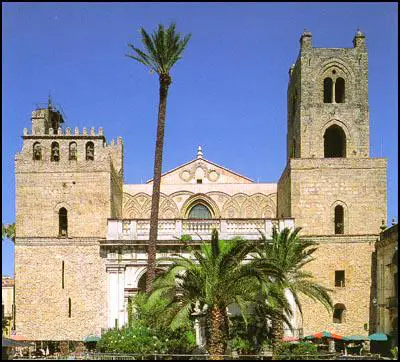
Hotel Elite: The hotel is a modern building in the very center of the town. It was fully restructured in 2002 so to offer the best comforts to its guests while maintaing the original architectural style. The warm welcome, the quality of the services and the kindness of the staff make the Hotel Elite the ideal place where to have some fine holidays or where to stay for businesses purposes.
Azzolini Palm Beach Hotel: The hotel is located on the beach of Terrasini, in a very beautiful position on the sea and, in the same time, very close to the city centre. All the rooms are provided with private bathroom, tub or shower, direct dial telephone, air conditioning, television. Restaurant with both Sicilian and international cooking, bar, solarium, private parking, beach. The proximity of Terrasini harbour allows to do every sea sport: wind-surfing, sailing, underwater fishing.
Amarcord Hotel: The hotel is located in the heart of Palermo, close to the two cultural symbols of Palermo, the Massimo Theatre and the Politeama Theatre. The property is at easy access from the train station, port, airport and the highway. The hotel has air-conditioned guest rooms that are comfortable and furnished with style and elegance. Every morning, guests can start the day with healthy breakfasts, offered at the on-site breakfast room.
Hotel President: The hotel is located at 50 meters from the port and very near to the centre town of Palermo and offers a stunning view on the sea. Renovated in 2000, the hotel distinguishes itself by the sumptuousness of its softened, relaxing environments furnished with the maximum comfort. The hotel has 129 rooms: 20 single rooms and 109 double rooms; 78 with window sea ; 119 with bath and 10 with shower. All rooms are equipped with bath or shower, phone, satellite TV, air, conditioning / heating, mini-bar, hairdryer, courtesy linen and correspondence set.
